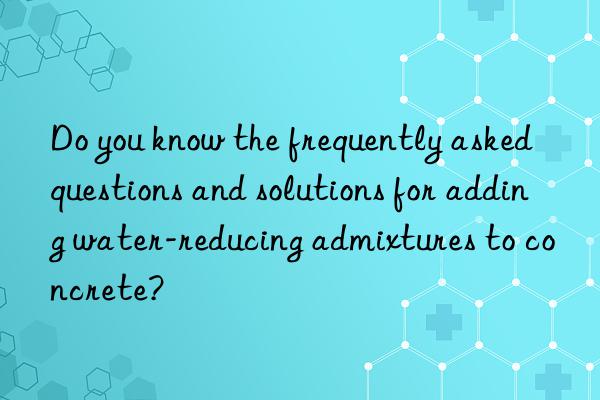
With the rapid development of China's social economy and the acceleration of urbanization, concrete admixtures are commonly used as ingredients in construction projects, and the construction industry has grown rapidly. Whether it is a high-rise or a multi-story building, it is inseparable. The use of concrete has become one of the important raw materials in construction projects, which directly affects the structural quality of construction projects. Admixtures that can quickly change the working characteristics of concrete are favored by construction companies. Concrete mixtures mixed with water-reducing agents will have problems such as sticking, false setting, non-setting, rapid slump loss, or lower strength after hardening. In construction projects, due to excessive use of pumping agents, concrete Solidification slows down.
1. The phenomenon of questionable settlement joints
The poured concrete will have a number of short, straight, wide and shallow cracks before and after the initial setting.
The reason is that mixed The concrete after using the water-reducing agent is more viscous, does not bleed, and is not easy to sink completely. It mostly appears above the steel bars.
The solution is to apply pressure on the cracks before and after the initial setting of the concrete until the cracks disappear.
2. Questionable sticky tank phenomenon: Some of the cement mortar sticks to the wall of the mixing barrel, resulting in uneven and less ash out of the concrete.
The reason is that the concrete is sticky, which mostly occurs when retarder is added. After water reducing agent, or in a drum mixer with a close shaft diameter ratio.
Solution
1. Pay attention to remove the remaining concrete in time.
2 .First add aggregate and some water to mix, then add cement, residual water and water reducing agent to mix.
3. Use a mixer with a large shaft diameter ratio or a forced mixer.
Three , Questionable false setting phenomenon
The concrete quickly loses fluidity after leaving the machine, and even cannot be poured.
Reasons
1. Calcium sulfate and gypsum in cement Insufficient content causes calcium aluminate to hydrate too quickly.
2. The water-reducing agent has poor adaptability to this type of cement.
3. The dosage of triethanolamine exceeds 0.05-0.1%. Initial setting is fast but not final setting.
Solution
1. Change the type or batch of cement.
2. Change the type of water reducing agent if necessary. Usually it is not used.
3. Reduce the water reduction rate by half.
4. Reduce the mixing temperature.
5. Use Na2SO4 to retard it. Dosage 0.5-2%.
4. Problems with non-coagulation phenomenon
1. After adding water-reducing agent, the concrete has not coagulated for a long time, even all day and night.
2. The surface oozes slurry and is yellowish brown.
Cause
1. The dosage of water-reducing agent is too large, which is likely to exceed 3-4 times the recommended dosage.
p>2. Excessive use of retarder.
Solution
1. Do not exceed the recommended dosage 2-3 times. Although the strength decreases slightly, the strength will decrease after 28 days. The result is less, and the long-term strength decreases less.
2. After final setting, increase the maintenance temperature appropriately and strengthen watering maintenance.
3. Remove the formed parts and pour again .
5. Questions about the symptoms of low strength
1. The strength is much lower than the test results of the same period.
2. Although the concrete has condensed, it has The strength is extremely low.
Causes
1. The amount of air-entraining water-reducing agent is too large, which makes the air content in the concrete too large.
2. Vibration does not work after using air-entraining water-reducing agent.
3. The water is not reduced or the water-cement ratio is increased instead.
4. The amount of triethanolamine is too large.
5. The quality of the water-reducing agent does not meet the requirements, such as the content of active ingredients is too low.
Solution 1. Use other reinforcement methods or re-pouring. 2. Strengthen vibration after pouring. 3. Take measures for the above reasons. 4. Identify this batch of water-reducing admixtures.
Six. Doubts about the phenomenon of excessive slump loss
Concrete loses workability quickly. , the slump decreases by 1-50px every 2-3 minutes after leaving the tank, and there is an obvious phenomenon of sinking to the bottom. This phenomenon is more likely to occur in concrete with large slump.
Reasons
1. The water-reducing agent has poor adaptability to the cement used.
2. The bubbles in the introduced concrete continue to overflow and the water evaporates, especially when using air-entraining water-reducing agents.
3. The concrete mixing temperature or ambient temperature is high.
4. The concrete slump is very large.
Solutions
1. Take measures to the cause .
2. Use the post-mixing method. The water-reducing agent is added after mixing the concrete for 1-3 minutes or even before pouring, and stir again.
3. Be careful not to add water.
p>
</p



 微信扫一扫打赏
微信扫一扫打赏
